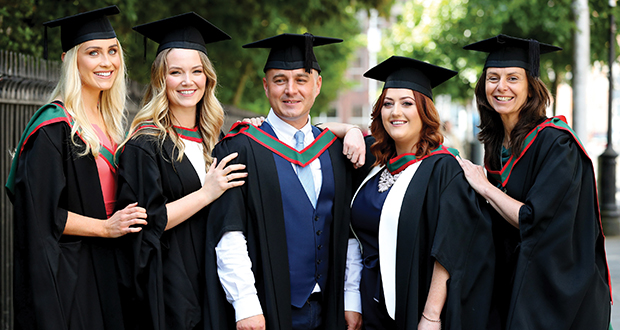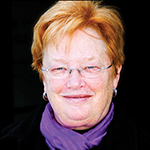The role of the emerging physician associate profession could make a difference to waiting lists in hospital emergency departments
A Physician Associate programme should adapt to the specific health needs of a country, Prof Ruth Ballweg tells Valerie Ryan, as the first Physician Associates in Ireland begin work to take on basic and routine medical care.
The role of the emerging physician associate (PA) profession could make a difference to waiting lists in hospital emergency departments (EDs) and the general practitioner (GP) workforce shortage crises, particularly in rural areas, believes Prof Ruth Ballweg, an advisor to the first Irish PA programme.
A bit of history was made at the Royal College of Surgeons in Ireland (RCSI) last month, as the first group of six PAs graduated with their MSc in Physician Associate Studies, with the majority already employed. The graduation of students in Ireland comes 50 years on from the first PA programmes in the United States (US). In January this year, RCSI welcomed the third cohort of PA students.
Applications are currently being accepted for January 2019.
According to the RCSI, PAs support doctors in the diagnosis and management of patients, and are trained to perform a number of roles including taking medical histories, performing examinations, making diagnoses and analysing test results.
Crucially, from the patient’s perspective, PAs can provide a continuity of care that is frequently absent in other healthcare roles.
Physician assistant
Attending that first graduation ceremony at the RCSI was visiting professor Ballweg, professor emeritus at the University of Washington and the recipient of the two highest awards in the physician assistants’ (US term) profession — the American Academy of physician assistants’ Eugene Stead Award in 2012 and the first Lifetime Achievement Award in 2015. Moreover, she was originally one of the first women physician assistants in the US.
She spoke to IMT about her career as a Physician Assistant as well as the origins, development and role of the profession.
One of the most common areas where these assistants were seen in the US was in emergency care. In the Irish context, she said three or four PAs in an ED could make a difference to waiting times, as they could see the simpler things, the earaches and so on, and move people out quickly.
Litigation was a huge issue in the US, and having a physician assistant decreased malpractice. It reduced waiting times for patients, and when you added a physician assistant, it expanded the number of people that could be seen in a practice.
A Physician Associate programme should adapt to the specific needs of a country and, in considering what Ireland needed, Prof Ballweg believed the PA profession should be promoted to the GP population and also to hospitals — but specifically to deal with ED back-ups.
Military origins
She started her career on the second Physician Assistant programme in Washington State, and it was designed to support doctors working in rural areas in the 1960s and 70s, where doctors were burnt out — sometimes they would be the only doctor in town — and so exhausted that they would move out overnight. In the beginning, these assistants were data collectors, taking “extremely compulsive histories and physicals”.
Like so many innovations in medicine, the physician assistants had their origin in the military.
“The original physician associates were all (medical) corpsmen who were returning from Vietnam. Regardless of what American people may have felt about the Vietnam War, they thought the real heroes were the corpsmen. They had a very special kind of training on the battlefield. They were in with the special forces, had an additional year’s training and were trained to do surgery.
“When they came back to the United States there wasn’t a place for them. At the same time, we had a lot of places, especially rural areas, where there weren’t any doctors and the doctors were leaving — we still have this problem.
“The PAs had a different role to a nurse but they ended up being very successful in rural areas, partly because the doctor wasn’t alone, he had somebody to talk to. The PA assisted in surgery and they still are very popular.
“It was a threatening idea for some people. It was felt by the American Medical Association that the term ‘physician associate’ was too collegial. Refusal of the term ‘physician assistant’ was a deal breaker and they said they were happy to support this.”
Opposite problem
“Then what happened was that they started to have some US physician assistants in the United Kingdom (UK) and started a pilot, and then programmes,” Prof Ballweg added. “They were having the opposite problem with the medical establishment at that time in the UK and they wanted to become members of the Royal College of Physicians, which they now are, and they suggested the name be changed to physician associate because it gave it more credibility.”
A marriage of roles
“It is up to the doctor you work with to decide what you do and that changes over time,” she said. Physician Associates tended to stay in posts and seldom changed jobs. She likened the relationship with the doctor as being “almost like a marriage in a way”. “You are very codependent on each other in a good way.”
The principle was that the doctor decided what the PA did but the overriding principle was that he/she was always available for consultation. The doctor had to agree to respond to any call from a PA while they were working with patients.
“The doctor is their quality control.” Legally, it was a hierarchical but collaborative relationship. While, more and more, nursing had developed its own model with different vocabulary and different terminology, both the doctor and the PA were trained in the medical model.
The PA worked throughout primary care, in the hospital and community services. Prof Ballweg said it was about the relationship. Working in countries such as New Zealand and Australia, she saw that every time the PA profession was introduced in a new place, older doctors could not imagine relinquishing any ground.
As younger doctors came up through the ranks, especially as PA programmes were in medical schools, they knew what it meant to work together.
A lot of younger doctors would say they would not work without a PA, or a nurse practitioner (NP) in their group. “Younger doctors know what it means to work together,” Prof Ballweg stressed.
Similarly, research showed patients aged 55 and older generally preferred to see their doctor, while those of 45 or younger wanted to be in a practice with a PA or NP. Matters moved along more efficiently as often the PA was assigned the quickest tasks which did not need the most talented person to do them. It created an efficiency which was also an economic efficiency.
Another typical example was a PA in an oncology ward where they might manage the patient’s care over a long period of time.
The doctors’ time was taken up with admitting new patients and making decisions on drugs, but the PA might be the person providing the day-to-day care. Another example was in orthopaedic surgery, where the PA often worked up the patients as they came in and followed on with the postoperative care.
Prof Ballweg started her career on the second PA programme in Washington State, which was designed with a focus on supporting rural practice in the 1960s and 70s.
What the data showed was that a PA could do 80 per cent of tasks in a GP practice, especially when they had the GP available to back them up. This was because there were many routine, time-consuming tasks, “It really improves the productivity of the practice. It is more efficient,” Prof Ballweg added.
Programme flexibility
The Irish programme was still in its early days. The idea was not to adopt the US way but to adapt to what was needed, linking it to the doctor allowed it to be flexible. In the process of developing a PA programme, the curriculum would be tweaked depending on what needs were determined.
PAs were usually paid at about 60 per cent of a doctor’s pay but a PA in a practice could also establish their own specialty areas. Prof Ballweg was a social worker before she became a PA at the time antidepressants had just come out.
She saw all the anxious depressed patients in their practice, “which I thought was wonderful. The doctor was happy as it was very time consuming.”
There was also a new programme in Ulster University in Northern Ireland, about a year behind RCSI which Prof Ballweg had visited and added that they saw themselves as having a more rural focus.
For the moment, the RCSI programme had more of an urban hospital focus but she did not anticipate that would remain the same in the long term. It was a very different premise to medical school. The RCSI two-year course was competency-based training and very practical, one year in the classroom and in clinical full time.
Prof Ballweg said: “You start with what you want the person to do and work backwards.” A number of elements were a given in a PA curriculum — continuous attendance was required and there was a lot of feedback throughout. In a PA programme, students learned a basic screening exam for admitting a patient and taking a history.
“Someone watches you and makes sure you can do it, there is a lot of demonstration and there is much more communication than there is in medical school. Typically, they are twice the number of hours of communications skills than you would see in medical school,” she added.
A look back
Looking back over the 50 years since the profession was introduced, she and her colleagues agreed it took a while to get it right. “There are lots of resources here. You have to orient everyone about what the PA needs to know, which might not be entirely everything the doctor needs to know.”
Prof Cathal Kelly, CEO/Registrar, RCSI said: ‘The physician associate role was introduced in the US more than 50 years ago and there are now more than 110,000 American physician assistants employed across a wide range of healthcare settings.
“In the UK, there are more than 30 programmes and almost 300 qualified PAs. Judging from the experience of the UK’s National Health Service, it is predicted that demand for qualified PAs will quickly grow in Ireland and RCSI is delighted to be at the forefront of this exciting new profession.”
 Irish Medical Times Medical News for Healthcare Professionals
Irish Medical Times Medical News for Healthcare Professionals







